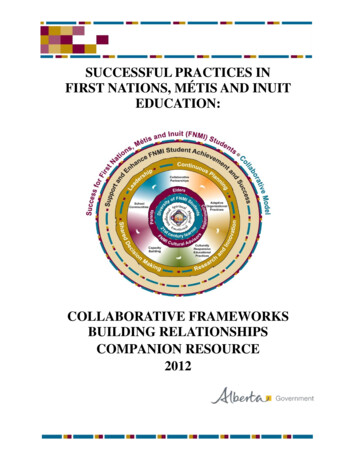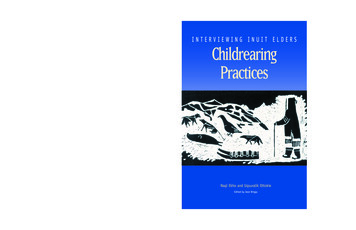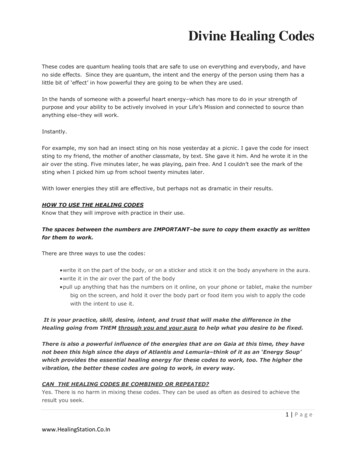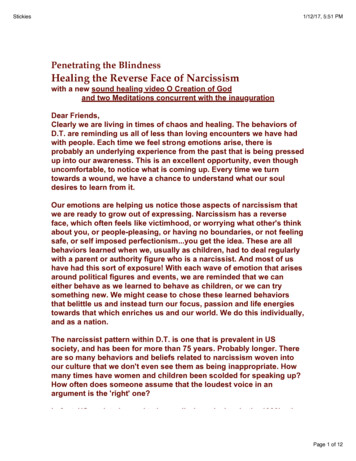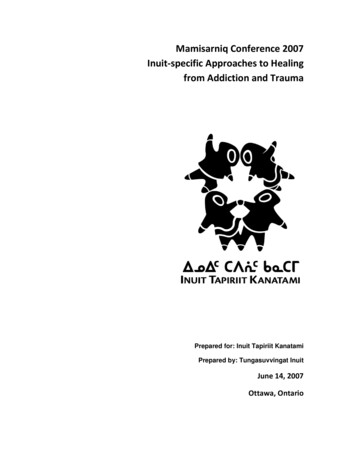
Transcription
Mamisarniq Conference 2007Inuit‐specific Approaches to Healingfrom Addiction and TraumaPrepared for: Inuit Tapiriit KanatamiPrepared by: Tungasuvvingat InuitJune 14, 2007Ottawa, Ontario
Table of ContentsExecutive Summary . 2Introduction . 5Conference Organization . 6Presentations . 7Honoring Abstinence . 7Traditional Inuit Healing Therapies . 8Nunalituqait Ikajuqatigiitut . 9Cambridge Bay Residential Treatment . 9Tungasuvvingat Inuit’s Mamisarvik Healing Centre . 11Qauma . 12Inuit Tapiriit Kanatami Open Discussion . 13So how was the conference? . 15Participant Comments: . 15Anonymous Written Evaluations:. 15Conclusion and Recommendations . 16This project was supported by ITK through a financial contribution from Health Canada. The views expressed hereindo not necessarily represent the official policy of ITK, federal, provincial or territorial governments. They do providean accurate record of the proceedings of this specific meeting.1 Page
Executive SummaryWith financial support from ITK through Health Canada, Tungasuvvingat Inuit, the Ottawa Inuitorganization, organized and facilitated the second Mamisarniq Conference, May 29‐31, 2007 atGracefield Camp near Gracefield, Quebec, about 100 kilometres north of Ottawa.Mamisarniq Conference 2007 brought together addiction and mental health workers fromNorthern Regions and the South who are involved in providing Inuit‐specific mental health andaddiction services to achieve the following goals: Share effective Inuit‐specific approaches to healing Gain knowledge of a wide range of Inuit treatment and healing programs Discuss training needs and treatment options Network with colleagues from other regions Participate in care‐for‐the‐caregiver activitiesAs was the case with the ground‐breaking first Mamisarniq Conference April 5‐6, 2006 at theMinto Suites Hotel in Ottawa, which brought together Northern and Southern addiction andmental health workers for the first time to exchange ideas on Inuit‐specific services, the 2007gathering significantly exceeded organizers’ expectations.“The conference was about much more than just sharing information,” said conferencecoordinator and emcee Pam Stellick, Tungasuvvingat Inuit’s Director of Counselling Services, asthe gathering concluded. “There has been true healing and bonding. Being out here away fromthe city and its distractions has really brought us together. Thank you for sharing such preciousthings with us, not just in your presentations but in the healing circle and the gifts of yourcompanionship and friendship.”The valuable and extensive networking experience created by the 2006 conference wasexpanded upon and taken to a deeper and more intimate level by conducting the 2007conference in the beautiful and restorative setting of Gracefield Camp.The gathering brought together 17 workers from Cambridge Bay, Igloolik, and Pond Inlet inNunavut; Kuujjuaq in Nunavik; Nain, North West River and Happy Valley‐Goose Bay inNunatsiavut and from Ottawa.One of the great strengths of the conference was the diverse nature of the programs it featuredand their wide range of promising practices.2 Page
The opening presentation on the Honoring Abstinence Program was made by a five‐membercontingent from the Nunatsiavut Department of Health and Social Development (NDHSD),consisting of Jean Crane, Elder; Gwen Watts, Director of Mental Health and Addictions; ShirleyFlowers, Project Coordinator; Mina Campbell‐Hibbs, Nunatsiavut Assembly Member andJohannes Lampe, Interpreter/ Translator.Detailed and illuminating presentations also were made by conference elder Thomas Ootook ofPond Inlet on traditional Inuit healing therapies and by Siasi Irqumia and Martha Annanack ofKuujjuaq, on the mobile Nunalituqait Ikajuqatigiitut Program, which trains Nunavik communityleaders on trauma, addiction and suicide and also trains frontline workers.Grayling Malaterre spoke about the residential treatment program he facilitates at theCambridge Bay Community Wellness Centre. Tungasuvvingat Inuit’s Mamisarvik Healing Centreresidential trauma and addiction program was described by Stellick; Ginette Chouinard,Coordinator; Reepa Evic‐Carleton, Trauma and Addiction Therapist, and Sadie Hill, Intake andAssessment Worker.Monica Ittusardjuat of Igloolik, a teacher with the Nunavut Teacher Education Program, made apresentation on the Qauma Mobile Treatment Project for residential school survivors.ITK’s Catherine Dallas, Senior Policy Advisor, and James Cincotta, Senior Project Coordinator,tag‐teamed a frank open discussion about priorities for national advocacy on treatment andmental wellness issues and provided information updates in the field to conclude theconference’s formal agenda.The following are key recommendations from conference participants: Mamisarniq Conference to be held annually (unanimous) and also in the North Increase number of frontline workers attending conference Create a frontline workers’ association to address specific concerns in the field Add urban Inuit, consumer and frontline representation to the National TreatmentStrategy Working Group Add urban Inuit representative to the ITK board Resolve confusion about eligibility for and tracking of NADAAP funding Greater enforcement of laws prohibiting marijuana use in North Exchange more care‐for‐the‐caregivers techniques Increase resources to combat suicide3 Page
Help community members understand that substance abuse keeps them silent andblocks social change. Emphasize holistic approach to healing, including housing, social services and economicdevelopment4 Page
IntroductionThe intent of TI’s inaugural Mamisarniq Conference in 2006 was to create the first forum forface‐to‐face interaction between Northern and Southern frontline workers involved in Inuit‐specific trauma and addiction and mental wellness issues, many of whom had beencommunicating for years by telephone and e‐mail alone.One of the most important results of that seminal gathering was that a powerful sense ofnetwork emerged, especially for Northern workers who felt isolated in their communities.The 2007 edition of the conference continued to build on that sense of network and followed upon one of the 2006 conference’s key recommendations, namely to “Bring Northern andSouthern frontline workers together to present on their Inuit‐specific programs and services.”TI’s Pigiarvik House residence was utilized to accommodate conference participants afterarriving in Ottawa. A reception and feast were held there on the evening of Monday, May 28.TI decided to stage the 2007 gathering at Gracefield Camp, where it takes its clients for intensivework during the fifth week of its treatment cycle.“This is a healing place,” said Reepa Evic‐Carleton of the 280‐acre, spiritual environment in theUpper Gatineau Valley, where many clients have undergone major transformation. The campitself was a significant player in the event, with its two kilometres of shoreline on Lac Castor and20 kilometres of hiking paths through mixed forest and rolling hills along the Trans‐Canada Trail.The setting promoted networking and self‐care opportunities of a profoundly more intimatenature than those of a city hotel, with canoeing and bonfires accompanied by drumming andsinging built into the agenda. A very powerful healing circle was led by Thomas Ootook. Justbefore returning to Ottawa, conference‐goers were deeply moved by the meditative force ofwalking the twisting paths of the camp’s intricate labyrinth, a first experience for most.5 Page
Conference OrganizationTI’s Mamisarvik Healing Centre staff organized and facilitated the conference.The organizing team consisted of:Conference Coordinator:Pam Stellick, Director of Counselling ServicesConference Emcee:Pam Stellick, Director of Counselling ServicesProgram Committee:Reepa Evic‐Carleton, Trauma /Addiction TherapistGinette Chouinard, Treatment CoordinatorPam Stellick, Director of Counselling ServicesGordon Johnson, Residential CounsellorTransportation Coordinator:Christine Lund, Diabetes CoordinatorTranslation Coordinator:Reepa Evic‐Carleton, Trauma and Addiction TherapistFinances:Jason LeBlanc, Financial AdministratorSupport Staff:Sadie Hill, Intake and AssessmentJeanie Schofield, CookLeeanne Anawak, Residential CounsellorRuby Arngna”naaq, Residential CounsellorRick Mayoh, Residential CounsellorTranslation services were ably provided by July Papatsie and Simona Arnatsiaq.6 Page
PresentationsHonoring AbstinenceThe enthusiastic, five‐member group from Nunatsiavut got the conference off to a high‐energystart with a multi‐media presentation on their Honoring Abstinence Program. All are membersof the Community Healing Advisory Committee of (NDHSD). They drummed, sang and presenteda slide show.The Honoring Abstinence program can be established in almost any community with very littlecost and celebrates people in recovery, those who have become role models, mentors andsupports. Its goal is to help build healthy individuals, families and communities by supportingthose who have traveled along their healing journey. They share success, ideas and resources ina community‐oriented group that has become an alternative to Alcoholics Anonymous.“It was really good for me to have someone recognize that I’m sober,” said Shirley Flowers ofHappy Valley‐Goose Bay, a NDHSD Project Coordinator.“‘Since Gosling Lake’ is our landmark,” said group elder Jean Crane of Happy Valley‐Goose Bay, avery youthful 78 years old. The group developed out of a retreat at Gosling Lake, near GooseBay, Oct. 27‐29, 2006.It is open to Nunatsiavut beneficiaries with three or more years of abstinence from drugs andalcohol and has grown to about 30 members, who meet once a month. A spiritual drummingcircle of 12 members has also emerged from the group.“People are finding the courage to say ‘If we could do it, you could do it, too,” said JohannesLampe, a lay pastor in Nain, where a second group has grown out of the original one in HappyValley‐Goose Bay. There are plans to start Honoring Abstinence groups in every Nunatsiavutcommunity. “People feel it’s a safe place to be real. We talk about feeling like a family. We oftentalk about how we’ve seen miracles.”The concept grew out of the Nunatsiavut Alcohol and Drug Committee Hearings that traveled toeach community in 2006. The Honoring Abstinence Group focuses on spirituality and teachingsto support the caregivers, who then create supports in the community.“We are connected in many different ways,” said Gwen Watts, NDHSD Director of Mental Healthand Addiction Services. The group focuses on the power of positive thinking, forgiveness, talkingcircles, healing from residential schools and music and entertainment.7 Page
“The drum frees my spirit,” said Nunatsiavut Assembly member Mina Campbell‐Hibbs of NorthWest River. “A man is a product of his thoughts,” she said, quoting Mahatma Ghandi. “What hethinks, he becomes.”Another Honoring Abstinence retreat at Gosling Lake is planned for June 22‐24, 2007.Later in the conference, Lampe spoke of the “Memory Wall”, another event that took place inhis home community. This project provided safety and support for people to remember andgrieve loved ones who have died from suicide, accidents, illness or natural deaths. The projectwas successful in helping many people cope with these painful losses.Traditional Inuit Healing TherapiesThomas Ootook’s powerful offering was rich in traditional analogies. The conference elder, 63,from Pond Inlet, was a corrections guard with the RCMP for 20 years until retiring recently andstarted his own healing journey in 1994. He has conducted healing circles and counselled in 13communities.He had a considerable impact on the conference participants with his clear, direct and rigorouslyhonest stories that repeatedly delivered the message that healing comes when trauma is facedhead on and discussed.A strong example of one of the analogies that came from his flip chart of images centered on apicture of a food cache.“There is caribou meat in there,” Ootook said. “It is covered with rocks to keep the animals out.There is nutrition in there but the rocks have to be taken off to get to it. I will look for help torelease that rock. It comes out through my mouth. Some are small, some are large.“The biggest ones on the bottom are the toughest. They have to come out through our mouths.Sometimes men cry with the sound of the snowmobile and release their pain. We just have toget rid of those rocks one by one to release all of that good food.“The biggest one is right inside your stomach. Problems keep piling up on top. Without releasingall of that pain, we pile them up very high. We need to speak. What saved my life was mymouth. I had the courage to talk about my pain and it saved my life.”The elder introduced many other analogies involving icebergs, tents, dog teams and tangledwhale nets and spoke of trauma issues affecting the soul, spirit, physical body and emotions.“I can give my trauma to someone else,” he said. “If someone gives you this lateral violence, letthem talk. You don’t take ownership of other people’s problems. If you never address your owntrauma issues, you are never grounded and home. Make a commitment to cut the cord. Onceyou let your baggage go, you will feel very light.”8 Page
Nunalituqait IkajuqatigiitutSiasi Irqumia of Kuujjuaq is Program Manager of the Nunalituqait Ikajuqatigiitut program, whichis celebrating its 20th year this year. The program offers community workshops on trauma,addiction and suicide for community leaders and training for frontline workers.It is a support program funded by Health Canada and NADAAP and does not do individualcounselling but it is developing a connection with the Isuarsivik residential treatment program inKuujjuaq.“I believe Inuit have to work with Inuit, that we have the capability and the solutions,” Irqumiasaid. The program offered training to community leaders in Kuujjuaq in 2005, to frontlineworkers in Inukjuak and Kuujjuarpik in 2006 and plans further sessions with communities on theHudson Bay and Ungava Bay coasts this year.Irqumia discussed definitions and types of trauma, including single‐episode, repetitive andmulti‐generational. She offered a very detailed history of Inuit trauma in Nunavik and outlinedher program’s four‐day trauma course for community leaders and four‐week course for frontlineworkers, both tailored to community needs.“We feel a loss when we go through trauma, like death,” she said, discussing her ownexperience with sexual abuse. “Many people commit suicide because of unresolved trauma.”She discussed the effects of trauma at various ages and of multi‐generational trauma when it isunresolved: “Future generations become the carriers of all the unresolved trauma of the past. Itbecomes multiplied.“The only way you can help is to help yourself first. We need to be healed, we need to begrounded ourselves.”The program has a fulltime secretary and four addiction workers, two fulltime and two part‐time.Cambridge Bay Residential TreatmentGrayling Malaterre has been facilitating residential treatment through the Cambridge BayCommunity Wellness Centre for 15 years. He was quick to voice his gratitude that, unlike manyother conference participants, the ever‐present issue of funding for his four‐week program isnot on his personal plate. Wellness Centre director Alice Isnor identifies and secures financialsupport for the program.“We are also fortunate to be under the auspices of the Hamlet of Cambridge Bay and so we arenot reliant on one source of funding,” he said.9 Page
He described his intensive program as being “not for the people who need it but for the peoplewho want it” and emphasized that participants are not bad people trying to get good.“We (addicts) are either going to be locked up, sobered up or covered up,” said Malaterre, whostrikes a blow for self‐care by taking three months off from his challenging work each year.His program features pre‐treatment, a graduation involving the community and a structuredfollow‐up within three months. It was recognized by the justice system for helping to reduce thenumber of charges on the Cambridge Bay court docket to 75 from 200 in the community of1,500 people.Malaterre describes his clients as battling denial, crime, complacency, parenting shortfalls, lackof a support system and the effects of residential schools and intergenerational trauma. It isdesigned to address addiction while providing time and safety to work on core issues. Care istaken to ensure roommates are compatible.The program is facilitated by Inuit staff (except for Malaterre, who is Metis). It concentrates oncomponents dealing with trust, feelings, self‐esteem and communication, addictions, anger andgrief, family violence, relationships and families, relapse prevention and self‐care and transitionfrom treatment back to home and community. The model includes healing circles, recreationand Alcoholics Anonymous, both in‐house and in the community.“We visit the two‐bay garage in town where the caskets are stored, we visit jail and thegraveyard. This is a matter of life and death.”Malaterre screened a video on unresolved anger by respected authority Ernie Larsen.He said personal self‐care plans are created with clients and copies are sent to othercounsellors and probation officers in the community: “It’s important that people are heldaccountable.“Before participants return home, we’ll go to their apartments, put some groceries in the fridgeand do some painting to show something has changed.”10 P a g e
Tungasuvvingat Inuit’s Mamisarvik Healing CentreGinette Chouinard, Treatment Coordinator; Reepa Evic‐Carleton, Trauma and AddictionTherapist; Pam Stellick, Director of Counselling Services and Sadie Hill, Intake and AssessmentWorker, outlined Mamisarvik’s trauma and addiction treatment program in Ottawa. It is fundedby the Aboriginal Healing Foundation and Government of Nunavut.“One of our best attributes is our flexibility,” said Chouinard, whose program has becomenational in scope and conducts four, eight‐week cycles a year. It includes pre‐treatment,assessment and aftercare for Inuit clients living in the North and South, for a total therapy offrom two to two‐and‐a‐half years.“We think it is important for clients to have choices. We offer both abstinence and harmreduction. There is residential and day treatment. There is exposure to Alcoholics Anonymous.”Mamisarvik’s treatment model is holistic, biopsychosocial and accommodates multiple andinter‐generational trauma resulting from residential schools, dog slaughter and forcedrelocation. Its assessments are valued by community systems such as justice and the Children’sAid Society. Ten of 13 staff members are Inuit and the program’s approach is to assist clients ontheir own voyage of self‐discovery. Developing and training Inuit counsellors is a high priority“Treatment is very directive and our program requires that the clients demand change ofthemselves,” said Chouinard. “We also focus a lot on taking care of ourselves. We work withstaff issues and really support each other.”Chouinard described the intense work clients undergo at Gracefield Camp concerning violenceand abuse, both as the abused and the abuser. Drawings are made on pictures of human formsto show where hurts have been received. Then clients go into gender groups for disclosure.Evic‐Carleton is a survivor of forced relocation and spoke about the great healing attributes oflearning Inuit history. Elders visit to help with that process and to teach traditional knowledge.“People begin to say ‘No wonder I feel this way,’” she said. “We have to be proud of who we areand where we come from.”She demonstrated the powerful Bowl of Pain exercise, in which clients squeeze drops of fooddye into a fishbowl and describe how their choice of color represents their pain. The water inthe bowl turns black as more disclosures are made. Then at the end of the sharing, a secretingredient (Javex) is added, which transforms the water into a clear, golden color, the color ofhealing.Stellick provided insight into Post Traumatic Stress Disorder and grounding techniques tomanage it. She said a screening tool used by her agency indicates the presence of PTSD in about11 P a g e
85 per cent of clients. Following eight weeks of treatment, these indications are significantlyreduced or gone for most.“People can feel like they are going crazy,” she said. “PTSD is a medical disorder. You’re notcrazy. What happened to you is crazy. We give the tools to be able to manage those emotionsand come out the other side safely. It’s all about empowerment and supporting healthychoices.”Hill was a client in the first of Mamisarvik’s 13 treatment cycles since 2003 and providedvaluable insight in describing her experience from a client’s perspective.“I got to be a professional quitter I wanted to become a social drinker,” she said. “The hardestpoint for me was telling my husband not to buy me any more white wine. I was really nervousabout going from one‐on‐one counselling into group therapy but I made it. Then I trained tobecome a residential worker, an intake and assessment worker and now I (facilitate) groupsmyself.”Qauma“Qauma means light, as in at the end of the tunnel, there is eventually light,” said MonicaIttusardjuat, of the name of her mobile program for residential school survivors, funded by theAboriginal Healing Foundation.The teacher with the Nunavut Teacher Education Program said Qauma resulted from the 1993Chesterfield Inlet reunion of residential school survivors.“We try to represent all of the survivors from Nunavut,” she said. The program has conductedfour‐week sessions in communities including Igloolik, Chesterfield Inlet, Gjoa Harbour, RepulseBay, Iqaluit and Rankin Inlet.Thomas Ootook and Arctic College educator Meeka Arnakaq of Pangnirtung are elders withQauma, which also benefits from the services of Ottawa’s Centre for Treatment of Sexual Abuseand Childhood Trauma.Qauma’s therapies are tailored to meet individual needs and can include massage, walking andworking with sand and children’s toys. Many clients are substance abusers and many areseparated from their partners.“We talk a lot about loss of family, isolation, abduction from our parents and how that affectedus,” said Ittusardjuat. “Betrayal and abuse and violence are main issues. There is a lot of self‐inflicted pain.”The main theme of the program is the importance of reconciliation and forgiveness and theBible is used as a central reference for healing. Much emphasis is placed on the core issue of12 P a g e
rejection and its causes. The subject is framed by the “roots and fruits” of rejection andidentifying the good and bad fruits.The three main roots are rebellion (fight response), self‐rejection (give‐in response) and self‐protection (hold‐on response) and each one produces its own fruit with its own costs.“Sometimes there would be 22 people involved in the circle. Sometimes there would beanimosity and hate but we overcame that.”Inuit Tapiriit Kanatami Open DiscussionITK’s Catherine Dallas, Senior Policy Advisor, and James Cincotta, Senior Project Coordinator, leda lively open discussion seeking priorities for national advocacy on treatment and mentalwellness issues. They also reported to the conference on their activities at the national level.Their efforts were highly appreciated by conference participants.“I want to thank both of you,” said Ginette Chouinard, Mamisarvik’s Treatment Coordinator. “Ilike your honesty. I’ve been to too many meetings in 30 years where we got illusions. It makesme feel real that you are not pretending with us.”The ITK duo spoke about attending a recent meeting of the National Treatment StrategyWorking Group, a group consisting of national organizations tasked with designing a nationalframework for treatment to be ready for implementation by March, 2008.One of the main focuses of the meeting was on system performance measurement, exactlywhat treatment information is important at the national level for such a framework.“Listening to everyone around that room, it was very clear there is no one‐size‐fits‐all,” saidDallas.“I’m in full agreement that we should measure what works and what doesn’t work but I think itshould be brought back to the frontline people,” said Chouinard. “There is no new money forthis. When there is money, the treatment organizations have to fight for it. The governmentplaces the responsibility on us when we are already limited in our resources.”Chouinard called for the establishment of a frontline‐worker association and said treatmentconsumers should also be involved in the planning.“We have to do this difficult work and then raise funds at the same time. Inuit people pay taxesand they shouldn’t have to beg for it.”Cincotta responded to Monica Ittusardjuat’s concerns about continued funding for the healingof residential school survivors. He said the First Nations and Inuit Health Branch (FNIHB) has13 P a g e
received a contract from Health Canada to provide counselling support for residential schoolsurvivors in all of the land‐claim areas. The details are not yet clear but he said a list ofcounsellors for each region is being compiled and there will be good access to such counselling.Ittusardjuat also inquired about what is being done to deal with soaring Inuit suicide.“At FNIHB, we continue to tell them that it is an epidemic and the funding has to be there,” saidDallas. “But it is not just about funding, it’s about human resources and building capacity and alot of other things.”Dallas said 13.5 million is being re‐profiled as part of the federal government’s focus on drugtreatment and enforcement. The money will be divided primarily between the provinces andterritories, with a small amount available federally for innovative programs.“We have also had a commitment from the Minister of Health to have an Office of Inuit Healthwithin FNIHB and that is being put together night now,” she added.Reepa Evic‐Carleton voiced concerns about urban Inuit representation and asked if a positioncan be created for a representative on the ITK board. Dallas replied that the idea is beingdiscussed.Thomas Ootook called for much more attention to be paid on the widespread use of marijuanain the North, saying many people who commit suicide are high at the time.Siasi Irqumia said much more than treatment money alone is needed in Nunavik: “What wereceive from NADAAP is not enough. I need housing, community‐based economic development this is Canada!”“There needs to be more of a focus on pre‐treatment and aftercare and applications for fundingaren’t friendly, they can be scary,” said Grayling Malaterre.Dallas also updated the conference on the progress of the Alianit Inuit Mental Wellness TaskGroup, which has developed a broad action plan.The five priorities of the plan are to ensure a continuum of culturally relevant mental wellnessprograms and supports; to recognize the strength in community roles and connections; toincrease community resources for the mental‐wellness continuum; to ensure that Inuit‐specificdata, research, information, knowledge and training are available; and to enableimplementation of an action plan through strong partnerships between provinces, territories,Inuit organizations, FNIHB and other government departments such as housing, social servicesand economic development.14 P a g e
So how was the conference?Participant Comments:Thomas Ootook: “It’s been a very good, successful meeting. I really like it. I’m always looking fora way to improve my healing circles.James Cincotta: “There is really a lot of strength here.”Shirley Flowers: “I’m proud to be here.”Ginette Chouinard: “We sang, we played, we got serious, we made new friends.”Siasi Irqumia: “It was the right thing to do to come here and get care for the caregiver.”Gwen Watts: “This has been a very powerful past few days. I wanted to get some Inuit‐specifictools. I’m looking forward to all of us networking.”Anonymous Written Evaluations:“I most liked how the presenters spoke from the heart, that we focused on the reality of thecommunities and not on theory. I liked how participants came from a perspective of compassionand have a holistic focus on healing. I thought Thomasie’s presentation was incredibly powerfuland he provided what I came here to
Cambridge Bay Community Wellness Centre. Tungasuvvingat Inuit's Mamisarvik Healing Centre residential trauma and addiction program was described by Stellick; Ginette Chouinard, Coordinator; Reepa Evic‐Carleton, Trauma and Addiction Therapist, and Sadie Hill, Intake and Assessment Worker.
